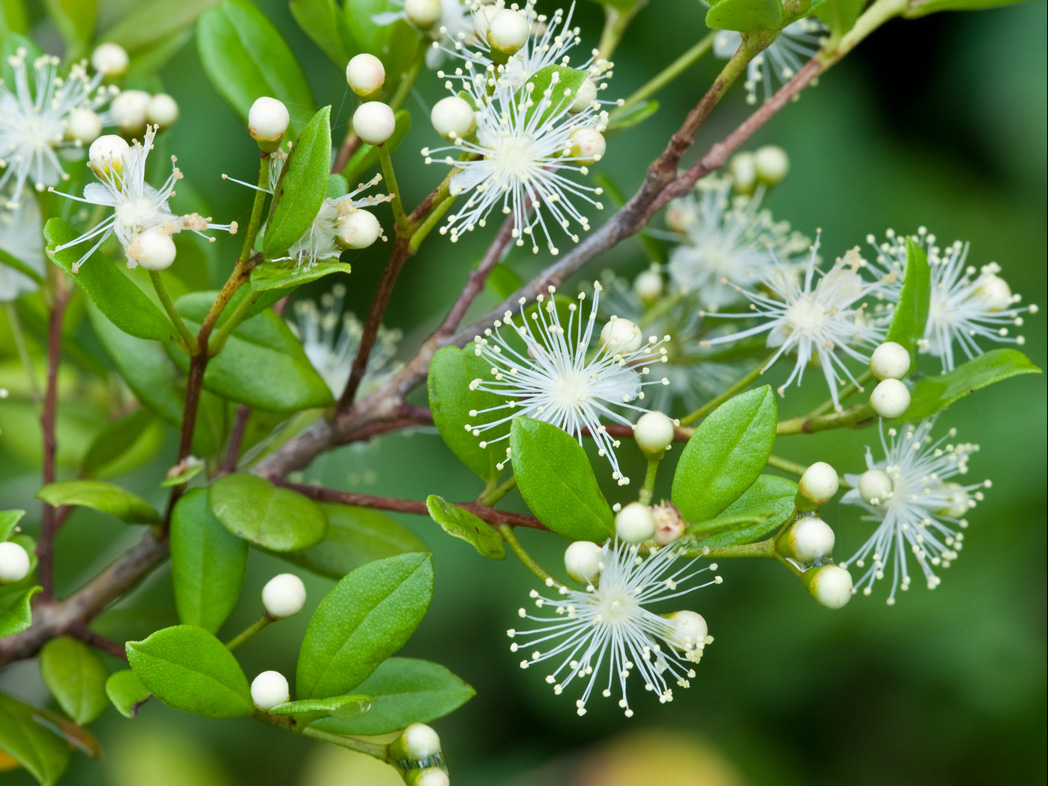Simpson’s stopper
Pictured above: Simpson’s stopper (Myrcianthes fragrans) by Keith Bradley. Click on terms for botanical definitions. View post as a PDF.
Also known as Twinberry, Simpson’s stopper (Myrcianthes fragrans) is an evergreen shrub or small tree that occurs naturally in coastal strands and hammocks. Its year-round blooms attract a variety of butterflies and bees; its fruit provides food for many bird species. The sweet flesh of the fruit is edible to humans, but eating the bitter seeds is not recommended.
Each fragrant flower has four white petals and many long white stamens. They are born in clusters on paired stalks. Sepals are lobed and in fours. Leaves are bright green, ovate to elliptic and leathery. They have entire margins and are oppositely arranged. Leaf surface is covered in small blackish dots. When crushed, leaves emit a citrusy or piney aroma. Fruits are greenish, ovoid berries that turn bright reddish-orange as they mature. They are typically born in pairs (hence the common name “twinberry”). Branches are stiff. Bark is reddish-brown and flaky.
The common name descriptor pays homage to Charles Torrey Simpson, an American botanist and naturalist who wrote several books about plants in South Florida. He was known as the “Sage of Biscayne Bay.” “Stopper” alludes to the plant’s historical use as a treatment for diarrhea.
Family: Myrtaceae (Myrtle or eucalyptus family)
Native range: Coastal counties along the central and southern peninsula, St. John’s County and the Keys.
To see where natural populations of Simpson’s stopper have been vouchered, visit florida.plantatlas.usf.edu.
Hardiness: Zones 8B–11
Lifespan: Perennial
Soil: Moist to dry, sandy or calcareous soils
Exposure: Full sun to partial shade
Growth habit: 3’–20’+ tall
Propagation: Seed, air-layering
Garden tips: Simpson’s stopper is an excellent ornamental plant with dense, evergreen foliage, attractive and fragrant flowers, and colorful fruit. Despite its limited natural range, it can be adapted to well-drained landscapes in northern Florida. It works great as a specimen or background shrub or grouped as a border, buffer or hedge. It is hardy and suitable for difficult areas where other plants may not do well. If left alone, this versatile plant will grow into a small tree, but it can be pruned to any desired form. More sun exposure will contribute to a smaller form and will encourage more blooms. In the shade, Simpson’s stopper may grow taller and have a straggly, untidy appearance.
Simpson’s stopper is available from nurseries that specialize in Florida native plants. Visit www.PlantRealFlorida.org to find a nursery in your area.
Learn more about Simpson’s stopper from the Florida Native Plant Society and the Institute for Regional Conservation.

